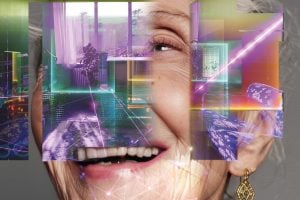
In a cozy apartment, an older woman sits in an armchair, raptly attuned to a scene unfolding on her virtual reality glasses. She chats amiably with a virtual tour guide, who is leading her through the Baltimore Museum of Art. Two Johns Hopkins graduate students—one in engineering, the other in nursing—sit nearby, taking notes to fine-tune this personalized, artificial intelligence-generated tool. It is aimed at providing social interaction to stave off loneliness, a significant risk factor for cognitive decline in older adults.
Down the hallway, Laureano Moro-Velazquez, an assistant research professor of electrical and computer engineering at the Whiting School, and neurologist Ankur Butala lead a man in his 70s through a series of reading and writing exercises on a digitized notepad. An array of sensors tracks the movement of the man’s eyes, the cadence of his voice, and the movement of his hand. The researchers will continue to assess the man’s reading and handwriting every few months. Their overarching goal: to detect neurodegenerative diseases like Parkinson’s or Alzheimer’s in their earliest-and most treatable-stages.
Meanwhile, in a large lab space nearby known as the “motion capture room,” Laura McDaniel, a second-year PhD student in electrical engineering, is quite literally putting an older woman through her paces. Sixteen cameras are set up in pairs throughout the room, tracking the woman’s gait in real time as she walks across the room, and then moves through a series of exercises on a treadmill. The data McDaniel collects, part of a study led by Rama Chellappa, Bloomberg Distinguished Professor in electrical and computer engineering and former interim director of the Data Science and AI Institute, is aimed at detecting factors-such as misaligned hips or hunched shoulders-that could impair the woman’s balance and put her at risk for a fall.
These three projects are just a few of many efforts that are unfolding—some now, others in the months and years to come—in a new hub for healthy aging research, which opened in July and celebrates its grand opening Nov. 19 at the Johns Hopkins Bayview Medical Center in East Baltimore. Under the umbrella of the Johns Hopkins Human Aging Project, or HAP, the 10,000-square-foot center gives the engineering school a prominent presence on the medical campus and is bringing together faculty and students from engineering and medicine—as well as nursing, public health, and business—with older adults and their caregivers to test technology-driven solutions to some of the biggest challenges older adults face.
These include social isolation, mobility issues, and neurodegenerative decline, notes Najim Dehak, associate professor of electrical and computer engineering at the Whiting School and co-director of the new hub. “Our aim,” he says, “is to leverage technology to extend the time that older adults can remain living safely and independently at home.” Dehak has even coined a term for this new area of translational research, which is reflected in the hub’s name: Geriatrics Engineering at Johns Hopkins.
Read the full article in the Fall 2025 issue of Johns Hopkins Engineering Magazine.